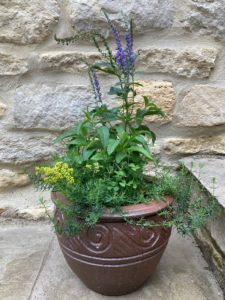


Seeing wildflowers in fields, woodlands or meadows in nature is a joyful experience with the open expanse, and nature’s palette of colours.
Yet however large or small your outdoor space may be, there is always an opportunity to grow wildflowers at home. In fact the more gardens or spaces which have a number of wildflowers and plants for pollinators, the more beneficial this will be to the enhancement of wildlife throughout the UK.
Creating corridors where bees, butterflies, insects, small mammals and birds can travel along and between is one of the key elements to creating a wildlife recovery network. Therefore everyone can play a part.
Growing wildflowers in containers is a great way to introduce a small number of wildflowers in an outdoor space.
Here are some tips:
- The wildflowers chosen can either be annual, (only last one year) or perennial (reappear every year).
- The soil in the container shouldn’t be too high in nitrogen, peat free if possible yet contain some nutrients to feed the plants through the season.
- Native Spring bulbs are great and if these are planted in Spring, once they finish flowering, the bulbs can be left in the container and other wildflowers planted on top
- Try to pick wildflowers with different heights so there are some low growing wildflowers at the edge and taller ones in the middle or towards the back.
- If planting several containers, it’s a good idea to repeat the chosen wildflowers, as this will allow pollinators to move between the containers.
- Having different flowering times across the season will increase the variety of wildlife.
Below is a list of wildflowers from Plant Wild which will grow well in a container.
Low growing:
Birdsfoot trefoil: yellow
Dog violet: purple
Wild strawberry: white
Primrose: pale yellow
Wild thyme: purple
Red clover: dark pink
Lady’s bedstraw: yellow
Harebell: blue
Taller growing:
Wild marjoram: purple
Spiked speedwell: purple
Field scabious: blue
Greater knapweed: purple
Red campion: pink
Toadflax: yellow
Annuals:
Poppy: red
Cornflower: blue
Bulbs
Winter aconites: golden yellow
Snowdrops: white
Wild daffodils: pale yellow
Grape hyacinths: dark purple
Snakeshead fritillaria: purple
So why not make a start and see if you can bring more wildlife into your world too.
